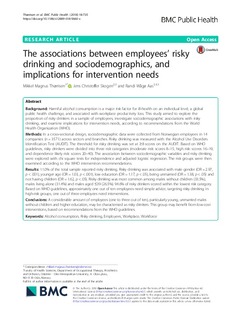| dc.contributor.author | Thørrisen, Mikkel Magnus | |
| dc.contributor.author | Skogen, Jens Christoffer | |
| dc.contributor.author | Aas, Randi Wågø | |
| dc.date.accessioned | 2018-12-18T10:00:53Z | |
| dc.date.available | 2018-12-18T10:00:53Z | |
| dc.date.created | 2018-05-30T14:39:03Z | |
| dc.date.issued | 2018 | |
| dc.identifier.citation | Thørrisen, M.M., Skogen, J.C., Aas, R.W. (2018) The associations between employees' risky drinking and sociodemographics, and implications for intervention needs. BMC Public Health. 2018, 18 (735) | nb_NO |
| dc.identifier.issn | 1471-2458 | |
| dc.identifier.uri | http://hdl.handle.net/11250/2578050 | |
| dc.description.abstract | Background
Harmful alcohol consumption is a major risk factor for ill-health on an individual level, a global public health challenge, and associated with workplace productivity loss. This study aimed to explore the proportion of risky drinkers in a sample of employees, investigate sociodemographic associations with risky drinking, and examine implications for intervention needs, according to recommendations from the World Health Organization (WHO).
Methods
In a cross-sectional design, sociodemographic data were collected from Norwegian employees in 14 companies (n = 3571) across sectors and branches. Risky drinking was measured with the Alcohol Use Disorders Identification Test (AUDIT). The threshold for risky drinking was set at ≥8 scores on the AUDIT. Based on WHO guidelines, risky drinkers were divided into three risk categories (moderate risk: scores 8–15, high risk: scores 16–19, and dependence likely risk: scores 20–40). The association between sociodemographic variables and risky drinking were explored with chi square tests for independence and adjusted logistic regression. The risk groups were then examined according to the WHO intervention recommendations.
Results
11.0% of the total sample reported risky drinking. Risky drinking was associated with male gender (OR = 2.97, p < .001), younger age (OR = 1.03, p < .001), low education (OR = 1.17, p < .05), being unmarried (OR = 1.38, p < .05) and not having children (OR = 1.62, p < .05). Risky drinking was most common among males without children (33.5%), males living alone (31.4%) and males aged ≤39 (26.5%). 94.6% of risky drinkers scored within the lowest risk category. Based on WHO guidelines, approximately one out of ten employees need simple advice, targeting risky drinking. In high-risk groups, one out of three employees need interventions.
Conclusions
A considerable amount of employees (one to three out of ten), particularly young, unmarried males without children and higher education, may be characterised as risky drinkers. This group may benefit from low-cost interventions, based on recommendations from the WHO guidelines. | nb_NO |
| dc.language.iso | eng | nb_NO |
| dc.publisher | BioMed Central | nb_NO |
| dc.relation.uri | https://rdcu.be/XxOX | |
| dc.rights | Navngivelse 4.0 Internasjonal | * |
| dc.rights.uri | http://creativecommons.org/licenses/by/4.0/deed.no | * |
| dc.subject | alkohol | nb_NO |
| dc.subject | alkohol i jobbsammenheng | nb_NO |
| dc.subject | ansatte | nb_NO |
| dc.subject | risikofylt alkoholforbruk | nb_NO |
| dc.subject | alcohol | nb_NO |
| dc.title | The associations between employees' risky drinking and sociodemographics, and implications for intervention needs | nb_NO |
| dc.type | Journal article | nb_NO |
| dc.type | Peer reviewed | nb_NO |
| dc.description.version | publishedVersion | nb_NO |
| dc.rights.holder | © The Author(s). 2018 | nb_NO |
| dc.subject.nsi | VDP::Medisinske Fag: 700::Helsefag: 800::Samfunnsmedisin, sosialmedisin: 801 | nb_NO |
| dc.source.pagenumber | 10 | nb_NO |
| dc.source.volume | 18 | nb_NO |
| dc.source.journal | BMC Public Health | nb_NO |
| dc.source.issue | 735 | nb_NO |
| dc.identifier.doi | 10.1186/s12889-018-5660-x | |
| dc.identifier.cristin | 1587797 | |
| dc.relation.project | Norges forskningsråd: 260640 | nb_NO |
| dc.relation.project | Universitetet i Stavanger: IN-11551 | nb_NO |
| cristin.unitcode | 217,13,1,0 | |
| cristin.unitname | Avdeling for folkehelse | |
| cristin.ispublished | true | |
| cristin.fulltext | original | |
| cristin.qualitycode | 1 | |

